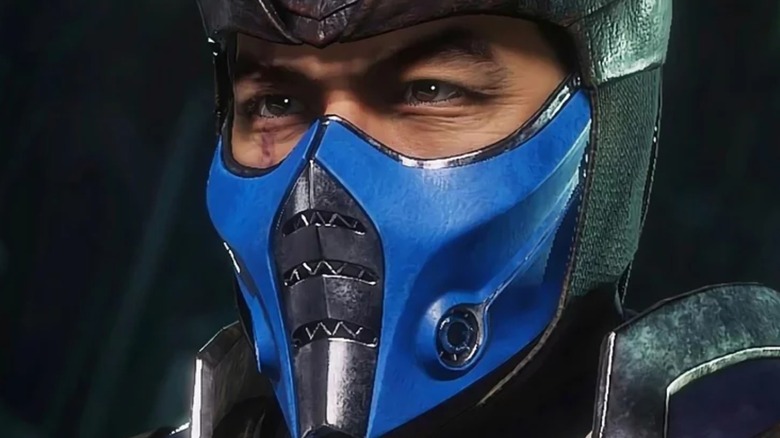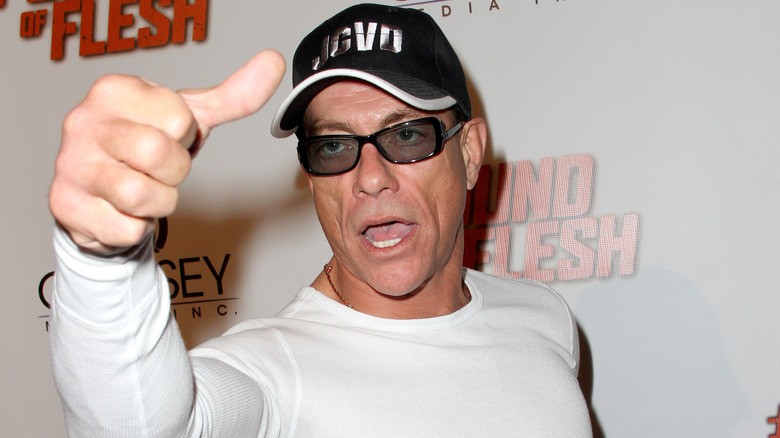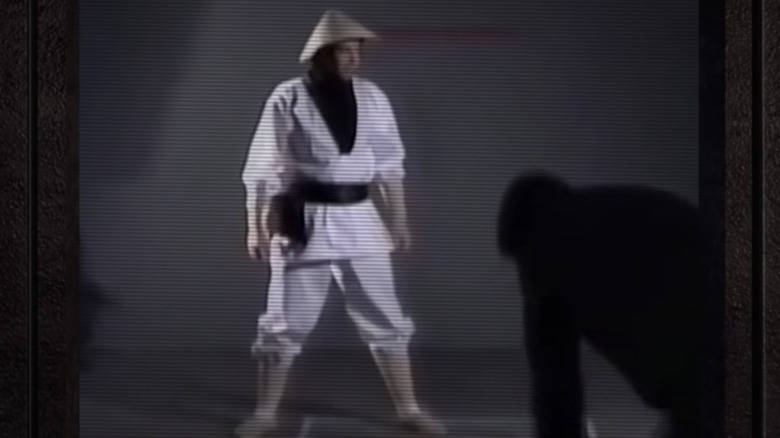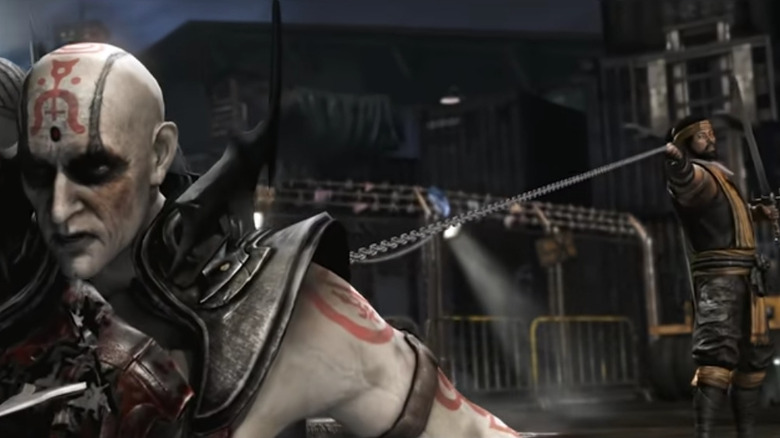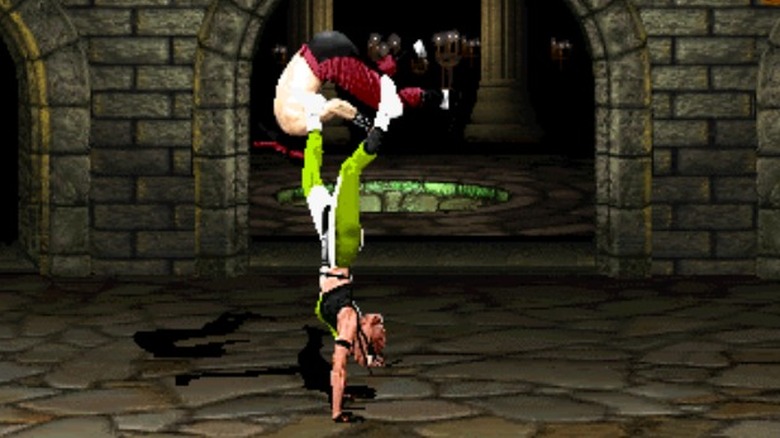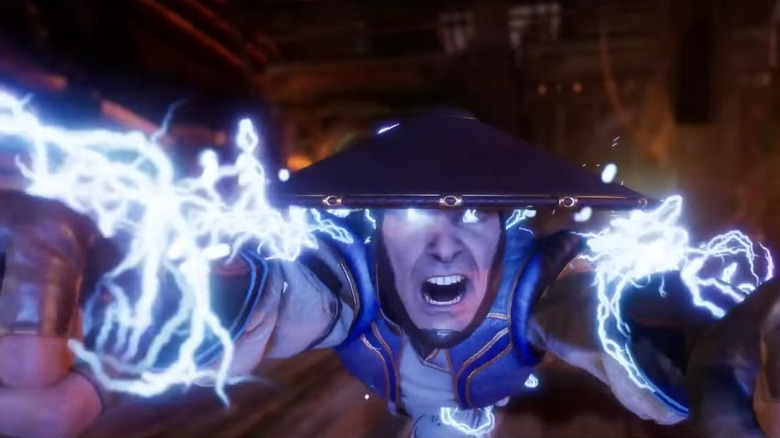What Mortal Kombat Looks Like Without Special Effects
"Mortal Kombat" has been attracting enthusiastic fans with its cinematic fight scenes and over-the-top gore since 1992. The game rose from humble beginnings to become arguably the most recognizable fighting game franchise in the world.
The "Mortal Kombat" series got its start in arcades before eventually expanding its reach to gaming consoles and even the big screen. The 2021 "Mortal Kombat" movie reignited the franchise's multimedia potential, and the series has gotten back embracing new genres through spin-offs. It turns out fans just can't get enough of the series's signature hyper-violence.
The visual flair of "Mortal Kombat" goes back to its very inception. The original game's developers used then-new computer software to digitize film footage in a way that allowed them to insert real-life actors into the action. That decision might have led to the creation of the ESRB, but it definitely blew gamers away and created a passionate fan base that could sustain the franchise for decades. Behind the scenes, "Mortal Kombat" is a lot less brutal — but somehow, without all the special effects, it looks even more impressive.
Mocap before it was cool
These days most people are at least a little bit familiar with motion capture technology. Bodysuits covered in dots and wearable face cameras have been used across media industries to help create the characters in "The Lord of the Rings," "Avatar," "The Last of Us," and so much more. In the early 90s, motion capture was still kind of on the fringes, but certain projects were beginning to change that. One of these was "Mortal Kombat," which got in on the ground floor of mocap tech.
The first installment of the "Mortal Kombat" franchise used a kind of motion capture to bring real-life actors into the game. If you've ever played the original, you know that all the characters look strikingly real for a game played on arcade consoles. The developers at Midway Games took a chance on an emerging technology, hoping that a more true-to-life look would set their game apart from the handful of other fighting games out there.
The gamble worked even better than the developers had hoped. Not only did fans love the look and feel of the game upon release, but the U.S. Congress took notice of the unique graphic violence in the "Mortal Kombat" franchise. After a congressional hearing about the game ignited worries about the government regulating video games, the Entertainment Software Rating Board was created to help get ahead of the issue.
Digitizing the captures
Today we say that the original "Mortal Kombat" used "motion capture" to create its characters, but it didn't work in the way you might think. Watching some of the original capture footage, it's easy to see there are some major differences between what the team at Midway did for "Mortal Kombat" and how motion capture technology works today. For one thing, the footage was captured with just a single, stationary camera, and the actors were all filmed one at a time. The most obvious difference, though, is that all the actors wore real costumes, not the dotted bodysuits that you would expect to see today.
Those differences are actually a pretty big deal. Instead of traditional motion capture, the developers used a new software process that allowed them to digitize frames of Hi8 footage. Those digitized images were then color corrected by the game's artists, and the backgrounds were painstakingly removed pixel by pixel. Then the digitized actor could be inserted into the games with the various frames strung together as animations for the character.
The technology had been used in other games, but nothing put it on the map the way "Mortal Kombat" did. Series co-creator Ed Boon told Game Informer: "It had such a reach that I think, in some ways, it got credit for doing stuff that Midway was already doing.
Finding the stars of Mortal Kombat
The characters of "Mortal Kombat" have kept fans returning to the game for over 30 years. Every game brings some new members into the "Mortal Kombat" family, but staples like Scorpion and Sub-Zero have returned for almost every game in the franchise. The game's characters became popular enough to inspire multiple movies, but back when "Mortal Kombat" was still just an idea at Midway Games, the developers thought a big movie star would help them sell their game.
Ed Boon told Polygon that the team behind "Mortal Kombat" originally wanted action star Jean-Claude Van Damme to be part of the game. If the deal had gone through, Van Damme would have been the actor behind Johnny Cage, and fans would have been using him to rip enemies apart for the past three decades.
Unfortunately, the Van Damme dream broke down in the early 90s. Instead of working with an established star, co-creator John Tobias hired local martial artists who he'd wanted to work with on a film project that never came to fruition. The fact that the actors weren't instantly recognizable to most gamers might have actually helped with getting people invested in the character they were controlling on the arcade console. In a full circle moment, however, JCVD eventually lent his likeness and voice to an alternate Johnny Cage in 2023's "Mortal Kombat 1," bringing a bit of "Bloodsport" flair to the tournament at last.
Costuming challenges
It's not just the characters who have reappeared across various "Mortal Kombat" titles through the decade, it's also their iconic costumes. Scorpion wears yellow. Sub-Zero wears blue. Raiden has an almost comically large hat on his head. The costumes give each character a more fleshed-out identity, plus they help make it easier to distinguish who's who in the middle of a heated battle.
All those costumes were locally sourced just like the game's actors. John Tobias and the martial artists he recruited pulled pieces from their own closets and gathered supplies and sports gear from stores in the areas. They kept each character's look as simple as possible to make production as easy as possible, but they also made sure that each costume stood out on its own.
The costumes themselves introduced new problems to the filming process. When in-game characters are drawings created by artists, costume pieces don't have to contend with real-world physics, but in front of the camera gravity gets to be a troublemaker. Ed Boon shared a story of costuming woe on social media: Raiden's hat would fly off his head during most maneuvers, even with a rubber band helping to keep it in place.
The costumes would eventually get more and more complex as the developers made more "Mortal Kombat" games, as can be seen in delightful behind the scenes footage of "Mortal Kombat 3."
Inventing signature moves
Working with real actors in a studio meant that the "Mortal Kombat" team could easily come up with new ideas for character moves and implement them on the fly. Sometimes the restrictions of working in the real world forced new ideas into existence. In Raiden's case, Ed Boon wrote on Twitter that there was no easy way to keep his hat on his head during his stand-up move, when he was supposed to leap from the ground onto his feet. Because of that, the developers gave Raiden the ability to teleport back to a standing position after being knocked down.
Other times the team threw in a new move simply because someone on set came up with a good idea. Boon shared a clip that shows how Scorpion's spear move came into existence. It literally began with Boon saying, "You know what would be a cool-[expletive] move?" The team worked out the details from there.
In the studio they filmed Scorpion's animations for the move, and later they reused reaction frames for the other characters instead of filming new ones because they needed to save precious memory space for the game. That quick bit of riffing on set led to the move that's arguably most synonymous with the "Mortal Kombat" franchise.
Creating characters on the fly
The "Mortal Kombat" team wasn't just making up fighting moves as they went along. As the original game got further into its development, the team also changed their plans to include a new character. Ed Boon shared the story of Sonya Blade's creation on social media.
Though Sonya is a quintessential "Mortal Kombat" character now, she almost didn't appear in the game at all. In the beginning, the game had only six characters, but after doing some testing, the team decided that they needed to expand the roster. Luckily, they already had a character in mind.
Curtis Stryker was a special forces operative who got involved in the tournament at the heart of "Mortal Kombat" because of an undercover operation. As the developers continued fleshing out their ideas, they decided that the game should have a female fighter, so Curtis' story was given to Sonya — who shortly thereafter got her iconic leg grab move. Over the years, though, the original character concept has continued to influence the game. His design transformed into Jax in "Mortal Kombat 2," and in "Mortal Kombat 3" his name was recycled into the character Stryker. Three for the price of one isn't a bad deal at all.
Modern motion capture
The method through which "Mortal Kombat" used real actors to create its fights gave the series a uniquely cinematic feel from the very beginning. The franchise broke new ground back in 1992, and since then it's continued to push the envelope in terms of graphics, gore, and the way actors bring video game characters to life. The original game's use of digitized graphics made it one of the earliest adopters of "motion capture" technology, but mocap has gone through some significant changes in the decades since "Mortal Kombat" first shocked people across the globe. Naturally, the series has kept up with the latest developments.
Modern "Mortal Kombat" games rely on real actors just as much as the original, but now they wear the dot-covered bodysuits that are typically associated with the mocap process. Behind-the-scenes footage for "Mortal Kombat (2011)" and "Mortal Kombat X" shows that the series is keeping its gritty realism by hiring actors to playing out the games' many fight animations. These days, the franchise also has much more of a focus on its story, and actors get to play out the cutscenes that gamers watch during their playthrough. Mocap is built into the very DNA of "Mortal Kombat," so don't expect actors to be cut out of the process anytime soon.
Fruit Ninja
Of course, the look of a flying kick or epic spear throw is only part of what makes the experience of fighting in "Mortal Kombat" so visceral and enthralling. The other part of the equation is the sound, and the excitement of audio special effects is no less incredible than the visual magic of motion capture.
Vice News went behind the scenes to discover the techniques that make the bone-breaking and flesh-ripping of "Mortal Kombat" sound so grisly and real. The next time you snap a friend's (virtual) arm in the middle of a battle, try to picture a man cracking peanuts in front of a microphone. The baseline for many of the series' nastier sound effects comes from smashing, slicing, stomping, and chomping fruits and vegetables in an audio booth.
Some of the sounds have a gruesome feel without any modification at all. A green pepper being twisted apart into a condenser microphone is a delightfully awful sound in and of itself, but the audio masterminds working on "Mortal Kombat" don't stop there. All of the recordings get processed, then layers of effects are added until they sound spectacularly brutal. Stephen Schappler, a senior sound designer working for NetherRealm Studios, told Vice that "on average it takes a day to two days to do the sound for one fatality." When that killing blow finally lands, all the work that went into it is much appreciated.
From storyboards to Story Mode
"Mortal Kombat" has come a long way from the days when it was being created with a small team of actors, a Hi8 camera, andjust a handful of computers. Though the core ethos behind the series is very much the same, the process of creating a "Mortal Kombat" game today looks a lot more like making a high-budget film than it once did.
Some of the developers who worked on "Mortal Kombat 11" showed off the overall design process they used on the game. It all started with detailed storyboards that plan out every character's moveset. That's not to say there's never any room for a cool move to be invented on the spot, but storyboarding helps the team plan out their vision and use their time more efficiently.
With the storyboards made, the team begins working on the motion capture. After that it's off to the animators, who transform the mocap footage into rough character models before passing the rough draft along again for further editing and cinematic adjustment. More and more edits are made along the way, with more details added to both the animations and the character models, until eventually the finished product lands in the hands of "Mortal Kombat" fanatics around the globe.

